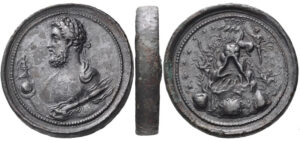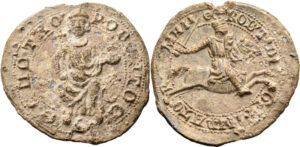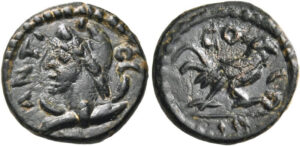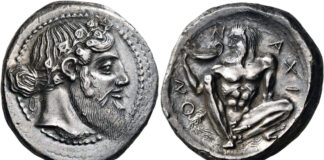Nomos 19 Featuring Spectacular and Remarkable Ancient Coins
On 17 November 2019 at, 16:00 CET Nomos AG will hold their Auction 19 in the Zunfthaus zur Saffran, Zurich. In this auction preview Alan Walker has chosen some intriguing pieces to give you an idea of what collectors can expect.
One big problem about producing an auction catalogue is the way that whenever you think you have finished writing it, someone runs in with a new consignment; yet, of course, given how computer programs work, you can insert the new lots with virtually no trouble at all! This still amazes me since I can’t help remembering how when Silvia Hurter was presented with a new coin for an already written catalogue, she would explain that she would happily put it into the following sale, since the present one was already finished. Our Dimitris would never say that! He’d happily tell the consignor that since the photography was only going to be done in two days, he would catalogue the coin (actually someone else would, but…), change the lot numbers and, hey presto!, we would suddenly have the 478 lots that we have in Nomos 19, not the perfect number of 400 we thought we were going to have!
But it is a very interesting sale, filled with coins estimated between a low of CHF 150.- to well over 100,000.-; in other words, something for everyone! One highlight of the sale is the presence of a selection of coins from the Trausnitz Collection, formed in Germany over the past generation. The owner was a passionate collector and a lover of the history of the ancient world, who greatly enjoyed working with his coins, studying them, touching them, talking about them and living with them: our next “Coming Attractions” newsletter will be devoted to those coins, but to introduce a number of very special items, designed to really whet your appetite!
Here is what is surely one of the most spectacular numismatic items we have ever presented:

This is lot 280, a massive (60 x 9 mm, 206 g), bimetallic medallion of Commodus that was struck in Rome at some point between c. 189 and c. 191: probably closer to 191 since it clearly illustrates that ever increasing megalomania, which culminated in the emperor’s assassination on 31 December 192. On the obverse we see a very large, laureate, and heroically nude bust of the emperor to left; in his left hand he holds Victory on a globe, an understandable part of the imperial regalia, but in his right he holds Jupiter’s thunderbolt, which would have certainly come as a shock to traditional Roman viewers! Emperors were often shown under Jupiter’s protection, but this bust implies that Commodus himself was a protecting god.
The reverse is even more exciting, and perplexing, as it shows us what appears to be Mt. Argaeus in Cappadocia, complete with wild animals, trees and rocks, being ascended by a galloping quadriga driven by a male charioteer (perhaps Commodus as Sol, or as just himself). To his left and right are two divine riders bearing torches to light, or to extinguish, the stars that are all around in the field (the riders are probably Phosphoros/Lucifer and Hesperos (the Morning and Evening Stars). This extraordinary medallion must have almost certainly been designed, or at least been inspired, by the emperor himself, but why it was produced can only be guessed at: we have made a few suggestions, which you can find in the extensive discussion in the Nomos 19 catalogue – the estimate is CHF 75,000). We owe a great debt of thanks to A. Burnett, W. Fischer-Bossert, K. Siegl and B. Woytek for their suggestions, comments and speculations on this piece (one of the real pleasures of numismatics is the way the collecting, commercial and scholarly world intersects and cooperates, and we all learn from each other).
The English word seal has a number of meanings. For most people it refers to an aquatic mammal, best known to numismatists for being the city badge of the ancient city of Phokaia (which actually means “Seal Town”). It is also the word used to describe the way openings are so closed as to be impermeable (like the airtight seals on airplane windows). More to the point, it also means the object carved in intaglio, whether out of metal, stone, wood, etc., that was used used to stamp a blob of a soft substance (clay or wax or lead, for example) designed to provide proof for a signature or to guarantee that an item was unopened. Finally, the word “seal” is used for the actual wax, lead, clay, etc. object on which the design cut into the seal(stone), seal(ring), or whatever, is impressed. It is the lead blobs, which were mounted on cords and then struck between the jaws of a seal press in order to authenticate a document (often known as a Bulla) or to secure a shipment, that concern us here.

The next “coin” we are going to present was produced over 1100 years after the medallion of Commodus was struck: it is lot 454 (estimated at CHF 5000), a large seal or bulla of the Latin Emperor of Constantinople, Robert of Courtenay, made in the 1220s. The Latin Empire came about when the Venetians and other Western leaders, in an example of aggressive capitalism that was a precursor to actions like the western annexations of parts of China, diverted the Fourth Crusade from its purported goal of Egypt to attack the Byzantines, who were fellow Christians but owed Venice money. The sack of Constantinople resulted in a nearly permanent break between the Catholic West and the Orthodox East, the destruction of ancient heritage that had survived for over 800 years protected by the Byzantines, the ultimate final destruction of the Latin states in the East, and the expansion of the Turks into Europe, which only ended with the Turkish defeat before Vienna in 1683.
The Latin emperors of Constantinople all had bad luck. The first, Baldwin I, ruled for only two years before, in 1205, being defeated by the Bulgarians, captured and having his skull made into a drinking cup; his successor, his younger brother Henry, was fairly successful but was poisoned in 1216. Yolanda of Hainault was the sister of Baldwin and Henry and this resulted in her husband, Peter II of Courtenay, becoming emperor in succession to Henry. After their coronation in Rome in 1217 they proceeded separately to Constantinople; she arrived but Peter II, on his way overland, was captured by Theodore Komnenos Doukas of Epirus and died in captivity, probably poisoned, in 1219. Yolanda ruled as empress during Peter’s captivity until her own death in the same year as her husband’s. By inheritance, the throne then fell to her second son, Robert, in whose name this seal was produced. He was finally crowned in 1221 and fought fairly unsuccessfully against the Epirotes and the Nicaeans; his bad luck continued with his plans for a marriage to the daughter of the Nicene emperor, Theodore I Laskaris, Eudokia Laskarina, falling through with a resounding clang. Next he married a certain ‘Lady of Neuville’, who had formerly been betrothed to a particularly vindictive Burgundian knight; as a result a conspiracy was launched against Robert I, which ended with his wife and her mother having their noses and lips cut off (both the cut off bits and, probably, the remainders were thrown into the sea). Robert then left Constantinople to seek help from Pope Gregory IX; on his way back, while staying with Geoffrey I de Villehardouin, Prince of Achaia, Robert seems to have really fallen sick and died in 1228. The family’s run of luck continued: Robert was succeeded by his younger brother Baldwin II (then 11 – he initially ruled under the regency of John of Brienne until 1237). Baldwin spent most of his rule losing territory and pawning the remaining Byzantine treasures: he was kicked out in 1261, thus ending the Latin Empire (a small force of Nicene troops entered through a secret passage while he was in his palace sleeping: waking and seeing the Nicenes he fled through the back door, never to return).
But this seal is certainly worthy of a luckier individual! It is also stylistically and linguistically intriguing. The obverse shows the crowned emperor, holding a long cross-tipped scepter and a globus cruciger, seated on a throne with lion supporters; around are his name in title in Greek. On the reverse is a wholly western depiction of the emperor, crowned and armored, on a horse galloping to right; around are his Latin titles. The Latin Empire was actually so impoverished that it never issued any even vaguely attractive coins in its own name (basically increasingly poor copies of earlier Byzantine issues); this seal is evocative of a deservedly doomed empire, extremely rare, and extremely important.

Now, as they used to say in Monty Python, for something completely different. The following coin, lot 172, (estimated at CHF 150) is by no means important, or major, or artistically exciting, or anything more than just plain fun!
It is a bronze (perhaps a hemiassarion?) issued by the Roman colony of Antioch in Pisidia, probably during the 3rd or 4th quarter of the 2nd century. On its obverse we see a bust of a male who wears a Phrygian cap and has a crescent on his shoulders: he is the autochthonous moon god, Mên. Turning to the reverse we see a rather determined-looking chicken – in fact, a rooster – striding to the right: why is he here? On the coinage of Himera in Sicily we have roosters because of a visual pun: the word himera means daybreak, which is when roosters crow; they also appear on the coinage of Mytilene, as a type and a symbol; and they appear as symbols on staters of Tarentum, on some Roman Republican denarii, and elsewhere. But their association with Mên in Pisidian Antioch is truly noteworthy: they had a huge vogue on coins in the late 2nd and early 3rd century, especially under the Severans. There must have been a connection between the god and the bird: perhaps the rooster helped to warn him of coming danger?
On the Nomos website you can browse through the complete auction catalogue.





